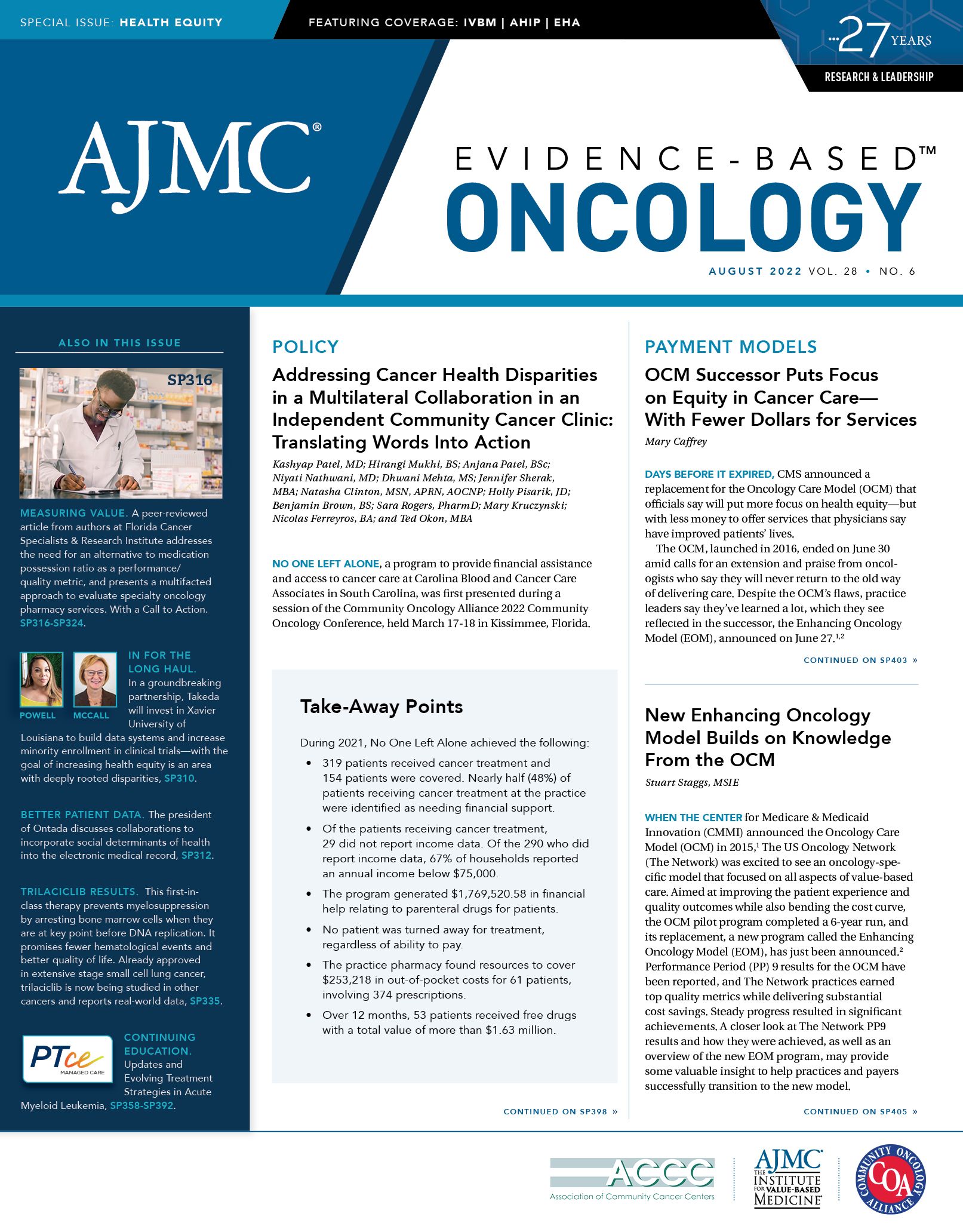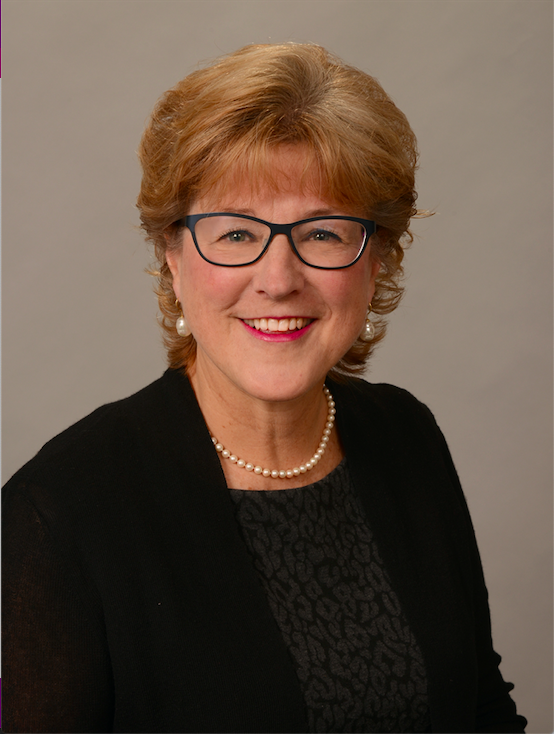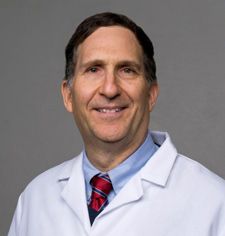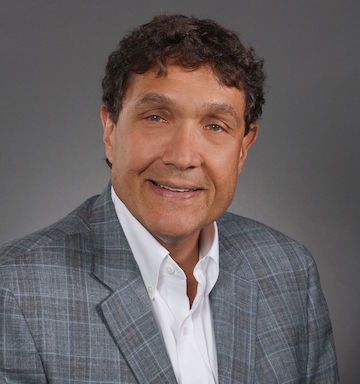Publication
Article
Evidence-Based Oncology
Zelenetz Discusses How to Evaluate Responses to Therapy in DLBCL
Author(s):
Andrew Zelenetz, MD, PhD, medical oncologist at Memorial Sloan Kettering Cancer Center, is the current chair of the Non-Hodgkin Lymphoma Guidelines panel of the National Comprehensive Cancer Network (NCCN).
Andrew Zelenetz, MD, PhD, a medical oncologist at Memorial Sloan Kettering Cancer Center in New York, is the former chief of the center’s lymphoma service and its current medical director of quality informatics. He has helped develop several agents now approved to treat lymphoma, including 131I-tositumomab/tositumomab, bortezomib, and pralatrexate. Zelenetz is the current chair of the Non-Hodgkin Lymphoma Guidelines panel of the National Comprehensive Cancer Network (NCCN) and vice chair of the Lymphoma Core Committee of the Cancer and Leukemia Group B.1
The author of more than 100 lymphoma research papers, Zelenetz studies both novel agents and the prognostic value of patients’ pathology specimens, using computer-aided image analysis. He spoke with Evidence-Based Oncology™ (EBO) about unmet needs in the treatment of diffuse large B-cell lymphoma (DLBCL), how to evaluate responses to therapy, and possible ways to identify which patients should be early candidates for chimeric antigen receptor (CAR) T-cell therapy, perhaps with next-generation sequencing (NGS). This interview has been edited lightly for clarity.
EBO: What do you consider to be the largest unmet needs in DLBCL?
Zelenetz: DLBCL is a heterogeneous disease. We can demonstrate that it is made up of at least 7 molecular subvariants. And we’ve made great progress with treatment: 60% to 65% of patients treated with rituximab and CHOP chemotherapy [cyclophosphamide, doxorubicin hydrochloride, vincristine [Oncovin], and prednisone] can be cured. But many patients are destined to progress after treatment. The recent trial of polatuzumab added to rituximab, cyclophosphamide, doxorubicin, and prednisone vs CHOP demonstrated improvement in progression-free survival, but thus far, no improvement in overall survival.2 So, we obviously need to make progress in the first line.
One [issue] is that the molecular subtypes we’ve identified are really laboratory based. We don’t have the clinically applicable tools to turn this around quickly, so that we can test targeted treatments that would be appropriate for these different subtypes. That’s one of the areas in the first line, once the disease recurs, where we have lots of unmet need—because the vast majority of patients with relapsed and refractory disease simply aren’t cured. Again, we’ve made great strides—the most standard treatment that we’ve used for many years in the relapsed setting is high-dose therapy with autologous stem cell rescue, sometimes co-autologous stem cell transplant. This is a curative regimen, but it’s a curative regimen based on intent to treat in about a third of patients. The patients who have short remissions of less than a year, or those who simply don’t go into remission, actually have very, very poor outcomes.
Recently, 2 prospective randomized trials have shown that CAR T-cell [therapies] are potentially an improvement in that space.3,4 And axicabtagene ciloleucel [Yescarta] was recently approved in that space.5 A third trial with tisagenlecleucel [Kymriah] was negative.6 So not everything is showing exactly the same results. And in the third line, CAR T cells have emerged in important treatment, but this itself represents an unmet need. CAR T cells are not universally available. They’re not universally appropriate for all patients because of the adverse effect [AE] profile. And many patients never get to CAR T-cell therapy because of their disease biology or because they lack access to the drug. So, there are lots of unmet needs here in the relapsed space in DLBCL.
EBO: You play a critical role as a member of the NCCN B-cell lymphomas guidelines panel. Can you walk us through your process of digesting and evaluating new information? What is your evaluation process, and what is the role of real-world evidence as you go through these regular guideline updates?
Zelenetz: The guidelines are updated in an annual 2-day meeting, then updated as needed other times during the year, particularly if there are new approvals. We frequently have a brief meeting in January after the American Society of Hematology [ASH] annual meeting, to make sure that there are no presentations or data that would require changes to our guidelines. It’s an ongoing process. As chair, I go through what I think are the most important data of the year, and I ask members of the panel to prepare presentations to review those data so that everyone is up to date. They know what the data are. Then, we discuss whether these changes and new information should be reflected in changes in the guidelines. Sometimes the answer is no, it’s not a significant enough change, and other times, yes, the standard of care has changed, and new treatments are added to the guidelines.
We use data from prospective randomized trials. We use data from large, well-done phase 2 studies. We prefer published full manuscripts, but sometimes full manuscripts can [appear 12 or 18 months] after critical data have [first] been presented. So [we try to] get the data ourselves to review—and most investigators are very generous and will provide the NCCN panel with the data. But real-world data are a legitimate source of data. Now, again, just like everything else, we’ll look at the quality and the consistency, and ask if the data are appropriate to use to make guideline recommendations. If we feel they are, then there’s no reason why we would say that real-world data shouldn’t be used.
The NCCN guidelines are a little different than American Society of Clinical Oncology [ASCO] guidelines. ASCO guidelines do a really deep dive in a particular area and make a decision. ASH guidelines are very similar, but the NCCN guidelines [reflect the] continuum of care from diagnosis through relapse, through second treatment, through third treatment, through fourth. We don’t have prospective randomized trials for every single point along a treatment decision, so sometimes we have to use the data that are available to us. And in certain circumstances, that will include real-world data to help inform us as to what we should do, so we can make recommendations across the continuum of care.
EBO: How do you evaluate responses to therapy in DLBCL? What are you looking for to determine whether a patient is successful in the first line? If a patient needs second-line therapy, how to you decide whether they’re heading to transplant, and need the appropriate therapy to prepare for transplant, if they are a candidate for CAR T or some other therapy?
Zelenetz: The response evaluation ironically starts before we begin treatments; we have to make sure we know where the disease is. Pretty universally today, FDG [fluorodeoxyglucose] PET is used to identify sites of disease in DLBCL. More than 98% of patients with DLBCL have FDG-avid disease. The bone marrow biopsy is often recommended, but if a PET scan clearly shows bone disease, there’s absolutely no reason to do a bone marrow biopsy in that setting, because you already know that the patient has involvement of the bone. Sometimes other sites need to be evaluated, and the brain might be appropriate in certain circumstances; lumbar puncture with flow cytometry might be appropriate. That’s all done before, so we know where the disease is. Then after treatment, we want to look where the disease was originally—is it all gone?
We have a number of different response criteria. The Lugano response criteria look at both the size of lymph nodes [and provide] guidance for the use of FDG PET scan.7 In the Lugano response, we look at the sum of the perpendicular diameter, meaning we measure lymph nodes in 2 dimensions, multiply those 2 numbers, and add up to 6 indicator lymph nodes. We also look at the PET scan; the PET scan is rated based on how much uptake remains relative to normal organ. If there’s no uptake whatsoever, it’s a 1; less than mediastinal blood pool, it’s 2; less than liver, it’s a 3; more than liver, but not a lot, it’s 4; and a lot, or new lesions, are 5. You [might think] that 4 and 5 are a little bit hazy—and [they are]. But typically, in most studies, Lugano 1, 2, and 3 is determined as a negative, or a complete response, and a Lugano 4 or 5 is incomplete.
In studies where you’re trying to limit the amount of treatment and you want to say, “Can I use the minimum amount of treatment?,” sometimes a more stringent criteria can be used. Here, Lugano 1 and 2 would be a complete response, and 3, 4, and 5 would be considered incomplete responses. RECIL [Response Evaluation Criteria in Lymphoma] also use PET, actually in a very similar way.8 But the big difference is that when lymph nodes are measured, they’re measured in 1 dimension and it’s up to 3 lymph nodes. There was some debate on whether we should use the short-axis dimension or the long-axis dimension; we used long-axis dimension in RECIL, and by comparing studies that were done with RECIL and originally done with Lugano the results are actually very comparable. And so we have reproducible ways of assessing response.
Now, does everyone use a Lugano response criteria for their patient in clinic? Most don’t, because these criteria really were designed for clinical trials. The more academic, the more research-oriented [clinic] is, the more likely you will see someone has a Deauville 3 response, or Deauville 2 response, or a Lugano 2 or 3 response.
EBO: It appears that clinicians use PET scans to gain as much information as possible about a patient and to monitor their response to therapy. Along those lines, you recently published a phase 2 study in which you used NGS to look at the dynamics of therapy, particularly in chronic lymphocytic leukemia (CLL). How might you see NGS monitoring help build that repertoire of information, similar to what you have with a PET scan, as you treat relapsed/refractory DLBCL in the future?
Zelenetz: One of the limitations of PET scans is that if we take all comers, [we see] more relapses in people who have negative PET scans than in those who have positive PET scans. A PET scan isn’t adequate to identify what we call minimal residual disease [MRD]; it’s simply not sensitive enough. Recently, in a CLL study, we looked at NGS for immunoglobulin gene rearrangements, and we found that the kinetics of response, or how quickly someone responded, divided patients into 2 groups: those who achieved undetectable MRD rapidly and were able to have a short duration of treatment, and a second group who took longer to achieve that same undetectable MRD and ended up getting substantially longer treatment.
Similar data were generated by the Alizadeh Laboratory at Stanford. They looked at cell-free DNA [cfDNA] and found that if you look very early after the initiation of workshop chemotherapy, if the level of cfDNA dropped by 2 logs, that was a very good predictor for outcome. Of course, these are just dividing patients biologically, using basically a real-time method to identify people with favorable or unfavorable biology. But in a large-cell example, if someone doesn’t achieve that rapid response, then you could conceive of taking them to a second-line treatment, maybe CAR T-cell therapy or something else, because you know that group will have a very poor long-term outcome.
EBO: Many patients are unable to proceed to transplant after their first-line therapy for a variety of reasons. What factors do you consider when you’re selecting that DLBCL patient for second-line therapy who wouldn’t be a candidate for transplant or can’t make it to that stage in therapy?
Zelenetz: Eligibility for high-dose therapy and autologous stem cell rescue is extremely variable. Essentially, some centers have literally no upper limit in the assessment of fitness; however, other centers will say, if you are 70 years and a day, you’re not eligible for transplant. We don’t have great hard and fast rules for this. But everyone will have someone they won’t transplant and sometimes a patient’s comorbidities will prevent anything relatively intensive, but it turns out that CAR T-cell therapies like tisagenlecleucel or lisocabtagene maraleucel are much better tolerated and less demanding than high-dose therapy and autologous stem cell rescue, so they can be given to people with comorbidities. So, that represents a potentially curative option for that group of patients who are “transplant ineligible.” But there are those patients who really are not eligible for any cellular therapy, anything aggressive, and those are the ones who we really want to put on clinical trials—trials in which we’re looking at novel treatments that could address critical pathways that might be abnormal in that patient’s tumor, using a more targeted approach that might have less toxicity.
EBO: Will something like NGS help us better identify those patients as we develop more and more targeted therapies? Could we use it across the spectrum in DLBCL, where NGS might be able to help us find out early on which patients would be eligible for such a therapy?
Zelenetz: It comes back to what I said earlier: Do we have the right tools to be able to translate molecular subtypes from the laboratory, which we can apply retrospectively to patient populations? Can we apply that prospectively and identify patients? NGS is an important component of that. And we can turn this around—using cfDNA will frequently help us with that. And that’s something that the Alizadeh approach showed, because they used cfDNA, but looked at a panel of genes. You could see what genes were mutated in the resistant population. And if appropriate targeted treatments existed for some of those mutations, you could have potentially have a clinical trial for that group. So yes, we need to be able to better characterize the molecular subgroups so that we’re not just throwing new treatments at people, but at least there’s some information. For instance, if [there is] an activated B cell, you’re more likely to have activation of NFκB downstream, which is downstream of the CARD11-BCL10-MALT1 complex, the CDM complex. There are novel inhibitors that can target MALT1, and early studies have shown some promise here.
Part of the problem that we have in large cell lymphoma is that we’ve identified a number of mutations and genes, but those genes don’t appear to be druggable. A perfect example is BCL6. BCL6 is a critical transcription regulator, but it just doesn’t seem to be druggable because the way it works is through protein interaction. However, there’s a new approach with proteolysis targeted chimeras, or PROTACS, where we can promote the degradation of these proteins and then potentially target them by making them disappear. And so, we have lots of potential options, including new antibodies, as well as antibody-drug conjugates. And then, an important area that is appropriate for some people who can’t get CAR T-cell therapy [is] bispecific antibodies. These are antibodies in which one part of the antibody binds to a B cell, often CD20; it’s been a pretty common target. On the other hand, the target can be a T-cell target and by bringing these 2 together, you activate T cells and try to get them to kill the tumor. So bispecifics are another important potential option.
EBO: What do you consider to be the most promising developments as you look forward in relapsed and refractory DLBCL?
Zelenetz: Again, I think the bispecific antibodies are critical here. Novel antibody-drug conjugate combinations of new naked antibodies are important. But I actually also think that attacking some of these undruggable targets with PROTACS will be important. Better targeting of the clearly abnormal pathways, such as with the MALT1 inhibitors or further upstream with [Bruton tyrosine kinase] inhibitors, are potential opportunities for certain mutations like EZH2 mutations. We have EZH2 inhibitors that have activity in a large-cell lymphoma. So, I think [advances will come with] really understanding the biology of the disease and trying to get patients with a more reasonable likelihood of responding. It’ll be not putting every patient in the same bucket, but trying to select patients based on their biology.
EBO: Would you like to share anything else ?
Zelenetz: DLBCL represents an oncology success story. In first-line, we are curing 60% to 65% of patients. If you’re treating a lot of lung cancers, it looks like the lymphoma doctors have it easy. But we’ve made relatively limited progress since the early 2000s, when we added rituximab to CHOP, despite our vast understanding of the biology. And this is in part because of that difficulty in translating those scientific discoveries into the clinic. In large part, [this is] because it’s been hard in real time, in the appropriate way to identify which lymphomas a patient has so that we can test different treatments for patients. We’re making some headway there—and we’re optimistic that we can do that. But even without these new drugs, there are opportunities to improve patient care and outcomes at major medical centers adjusted for patient mix, because that’s always the big criticism. But when you adjust for patient mix, it’s still better than in the community. Now this is partly related to accuracy of diagnosis and management of treatment-emergent AEs; but mostly, I think particularly in the relapsed/refractory setting, [academic medical centers] offer access to new and innovative therapies, as this is often limited in the community. It’s also limited by payers as well as by Medicare. So, increasing access to approved and available novel treatments can improve outcomes, and getting more patients from the community onto clinical trials to test some of the new hypotheses is going to be really important.
References
1. Andrew D. Zelenetz, MD, PhD, medical oncologist. Memorial Sloan Kettering Cancer Center. Accessed July 10, 2022. https://www.mskcc.org/cancer-care/doctors/andrew-zelenetz
2. Tilly H, Morschhauser F, Sehn LH, et al. Polatuzumab vedotin in previously untreated diffuse large B-cell lymphoma. N Engl J Med. 2022;386(4):351-363. doi:10.1056/NEJMoa2115304
3. Locke FL, Miklos DB, Jacobson CA, et al; All ZUMA-7 Investigators and Contributing Kite Members. Axicabtagene ciloleucel as second-line therapy for large B-cell lymphoma. N Engl J Med. 2022;386(7):640-654. doi:10.1056/NEJMoa2116133
4. Kamdar M, Solomon SR, Arnason JE, et al; TRANSFORM Investigators. Lisocabtagene maraleucel versus standard of care with salvage chemotherapy followed by autologous stem cell transplantation as second-line treatment in patients with relapsed or refractory large B-cell lymphoma (TRANSFORM): results from an interim analysis of an open-label, randomised, phase 3 trial. Lancet. 2022;399(10343):2294-2308. doi:10.1016/S01400-6736(22)00662-6
5. FDA approves axicabtagene ciloleucel in second-line treatment of large B-cell lymphoma. FDA. April 1, 2022. Accessed July 10, 2022. https://bit.ly/3RqnXzB
6. Bishop MR, Dickison M, Purtill D, et al. Second-line tisagenlecleucel or standard care in aggressive B-cell lymphoma. N Engl J Med. 2022;386(5):629-639. doi:10.1056/NEJMoa2116596
7. Yoo KH. Staging and response assessment of lymphoma: a brief review of the Lugano classification and the role of FDG-PET/CT. Blood Res. 2022;57(S1):75-78. doi:10.5045/br.2022.2022055
8. Younes A, Hilden P, Coiffier B, et al. International Working Group consensus response evaluation criteria in lymphoma (RECIL 2017). Ann Oncol. 2017;28(7):1436-1447. doi:10.1093/annouc/mdx097



